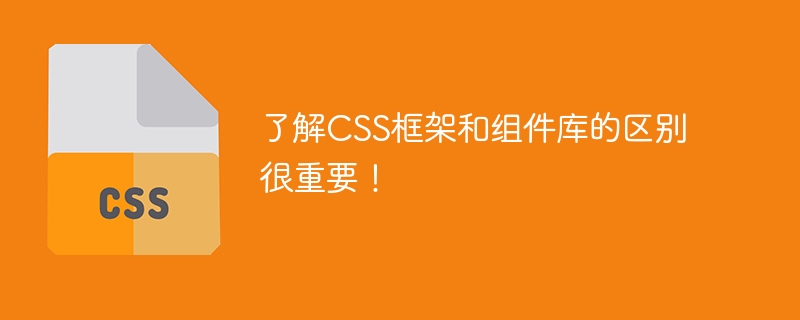

It’s important to understand the difference between CSS frameworks and component libraries!
With the rapid development of front-end development, CSS frameworks and component libraries have become developers' right-hand assistants. When building web pages and applications, they can provide rich styles and interactive components to help developers quickly build interfaces and improve development efficiency. However, many people are not clear about the concepts and usage of CSS frameworks and component libraries, and it is easy to confuse the difference between the two. This article will introduce the difference between CSS framework and component library in detail, and provide specific code examples to help readers better understand and apply the two.
First, let’s understand the CSS framework. The CSS framework is a collection of predefined CSS styles that provides a unified set of style specifications and organizational structure, including basic styles such as layout, typography, colors, fonts, buttons, etc. Using the CSS framework, developers can quickly build reusable interface components and reduce repetitive CSS code writing. Compared with hand-written native CSS, using a CSS framework can greatly improve development efficiency and ensure interface consistency.
The following is an example of a common CSS framework, Bootstrap:
<!DOCTYPE html>
<html>
<head>
<link rel="stylesheet" href="https://cdn.jsdelivr.net/npm/bootstrap@5.3.0/dist/css/bootstrap.min.css">
</head>
<body>
<div class="container">
<h1>Hello, World!</h1>
<button class="btn btn-primary">Click me</button>
</div>
</body>
</html>In the above example, we introduce the Bootstrap CSS file in the <head> tag , you can use the styles provided by Bootstrap. btn and btn-primary are Bootstrap CSS classes that can add styles to buttons.
The component library is a set of highly reusable UI components further encapsulated on the basis of the CSS framework. The component library encapsulates various commonly used interactive components (such as modal boxes, navigation bars, tabs, etc.) into directly usable components, and provides a series of configuration options and APIs to facilitate developers to customize and expand. Using component libraries can further improve development efficiency and reduce duplication of work, while maintaining interface consistency and user experience.
The following is an example of a common component library, Ant Design:
<!DOCTYPE html>
<html>
<head>
<link rel="stylesheet" href="https://cdn.jsdelivr.net/npm/antd@4.16.13/dist/antd.min.css">
</head>
<body>
<div id="app"></div>
<script src="https://cdn.jsdelivr.net/npm/react@17.0.2/umd/react.production.min.js"></script>
<script src="https://cdn.jsdelivr.net/npm/react-dom@17.0.2/umd/react-dom.production.min.js"></script>
<script src="https://cdn.jsdelivr.net/npm/antd@4.16.13/dist/antd.min.js"></script>
<script>
const { Button } = antd;
ReactDOM.render(
<Button type="primary">Click me</Button>,
document.getElementById('app')
);
</script>
</body>
</html>In the above example, we need to introduce the CSS file of Ant Design and the corresponding JavaScript library. Then, by using the components provided by Ant Design, we can easily create an interface with clickable buttons.
As can be seen from the above example, the difference between CSS framework and component library lies in the different levels of functions. The CSS framework mainly focuses on providing basic style specifications and organizational structure, while component libraries further encapsulate interactive components and provide additional functionality.
To sum up, it is very important to understand the difference between CSS framework and component library. The CSS framework can help developers quickly build interfaces with consistent styles, while the component library further provides reusable UI components and rich functions. Based on actual development needs, developers can flexibly choose and use the two together to improve development efficiency and user experience.
The above is the detailed content of Understanding the difference between CSS frameworks and component libraries is crucial!. For more information, please follow other related articles on the PHP Chinese website!
 The difference between static web pages and dynamic web pages
The difference between static web pages and dynamic web pages
 What is the difference between 4g and 5g mobile phones?
What is the difference between 4g and 5g mobile phones?
 The difference between k8s and docker
The difference between k8s and docker
 The difference between JD.com's self-operated flagship store and its official flagship store
The difference between JD.com's self-operated flagship store and its official flagship store
 What is the difference between css framework and component library
What is the difference between css framework and component library
 How to create a soft link
How to create a soft link
 Internet time query
Internet time query
 absolutelayout
absolutelayout
 Which exchange is FIL coin on?
Which exchange is FIL coin on?




